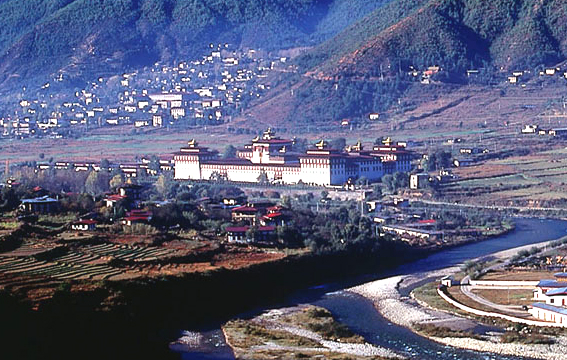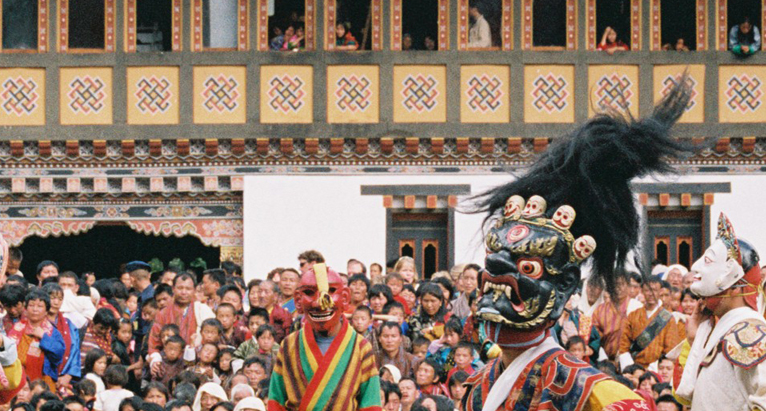
[ Thimphu Festival Tour | Thangbi Mani Festival Tour | Jambay Lhakhang Drup Tsechu Festival Tour | Black Crane Festival Phobjikha Tour | Punakha Domchey Festival Eight Nights Tour | Punakha Domchey Festival Ten Nights Tour | Chorten Kora Tsechu (arrive Paro, Depart Paro) | Chorten Kora Tsechu (arrive Paro, exit India) | Chorten Kora Tsechu (arrive India, exit Paro) | Gom Kora Tsechu (enter Paro, exit Paro) | Gom Kora Tsechu (enter Paro, exit India) | Gom Kora Tsechu (enter India, exit Paro) | Paro Tsechu Festival Tour | Paro Tsechu Festival 7 Dzongkhags Tour | Paro Tsechu Festival Tour with Druk Path Trek | Ura Yakchoe Festival Tour ]
Thimphu Tsechu Festival Tour
- 9 Nights 10 Days

Thimphu Valley, at peace with the environment... (Tashichhodzong
from the north side of Thimphu)
- Western Bhutan
Dzongkhags covered: Paro, Thimphu, Wangdue, Bumthang, Trongsa
Duration: 9 Nights 10
Days
Trip Cost: US$ 2290 per person.
Dates: Sunday, 08 September - Tuesday, 17 September 2013
Trip Grade: Easy.
Itinerary Outline:
Day 01: Arrive at ParoDay 02: Paro – Thimphu
Day 03: Thimphu Sightseeing
Day 04: Thimphu Tsechu Festival
Day 05: Thimphu Tsechu Festival & Sightseeing
Day 06: Thimphu to Gangtey/Phobjikha
Day 07: Gangtey/Phobjikha to Bumthang via Trongsa
Day 08: Bumthang sightseeing
Day 09: Bumthang-Paro
Day 10: Paro Departure
Thimphu Tsechu Festival:
The Thimphu Tsechu or Thimphu festival is held in a dance place adjacent to the Tashichhodzong. Every year the number of visitors, both tourists and Bhutanese had been increasing such that all the people could not be accommodated in the Dzong's courtyard. Thus this new dance place was constructed adjacent to the Dzong where more people can witness and enjoy the Thimphu Tsechu in comfort. Most dances in the program have religious significance. Folk dances are carried out by the Royal Academy of Performing Arts and is interspersed with religious mask dances. The Thimphu Tsechu was established by the 4th temporal ruler, Tenzin Rabgye in 1670 on the 8th month of Bhutanese calendar to commemorate the birth of Guru Rinpoche. Thimphu Tsechu is one of the most popular tsechus amongst visitors.
Detailed Itinerary:
Day 01: Arrive at Paro
On arrival at Paro International Airport, you will be welcomed and received by our representative from Bhutan Rebirth. After checking in to your hotel and resting for a while it's time to begin our holiday. First we'll visit the Paro Rinpung Dzong. We will also visit the Tag Dzong (watch tower for Rinpung Dzong) which is also the Paro National Museum. We can also go on a short hike, which starts from above the National Museum ending at Uma Paro. From this hike we can see the Paro Valley, the International Airport in Bhutan and other adjacent villages beautifully. Also, stroll around Paro town. Dinner and overnight stay at a Three Standard Hotel in Paro.
Day 02: Paro – Thimphu
In the morning we will hike to Taktsang Monastery (Tiger’s Nest). Taktsang Monastery is one of the most important pilgrimage sites in the Buddhism world and it is the one of the highlights of this tour. Lunch at Taktsang Cafeteria or in Paro. Then drive to Thimphu, the capital city of Bhutan, an hour's distance. Stroll around Thimphu town. We will also try some Traditional Bhutanese dinner. Overnight stay at Hotel in Thimphu.
Day 03: Thimphu Tsechu Festival

Today we will enjoy together with the Bhutanese the festivals that is Thimphu Tsechu (above). Later, time for more Indigenous & Authentic Bhutanese Dinner and overnight at Hotel in Thimphu.
 Day 04: Thimphu Tsechu Festival & Sightseeing
Day 04: Thimphu Tsechu Festival & Sightseeing
Today the first half of the day we will enjoy with the Thimphu Festivities (left- crowds at Thimphu Tsechu). At the heart of Thimphu visit the Third King's Memorial Chorten (Stupa) built in 1974 where you will find many devotees circumambulating the Chorten. You will also visit the Changangkha Lhakhang (Lhakhang means temple), Jungshi Paper factory where they make traditional Bhutanese paper, the National Library that houses the world’s largest book, ancient Buddhist texts and manuscripts, a Painting School famous for traditional thangkha (thangkha is a religious painting), the Folk Heritage Museum founded by Her Majesty the Queen Mother, Ashi Dorji Wangmo Wangchuck. The Museum is one of a kind that portrays the lifestyle of a genteel family in the Thimphu valley in the olden days. Visit the Choki Handicrafts shop where Bhutanese textiles and other handicrafts are displayed and can be purchased. The shop is closely linked to the Choki Traditional Art School- many of the goods are produced in the school itself and all proceeds go towards the upkeep of the school and the provision of tuition for its students. Later, visit the Tashichhodzong- The ‘Fortress of the Glorious Religion’- houses the throne room of His Majesty the King, the main Secretariat Building and the Central Monk Body. Its courtyard is open to visitors during the off-office hours- on weekends and weekdays after 4 pm during winter and 5 pm in the summer. Overnight at Hotel.
Day 05: Thimphu Tsechu Festival & Sightseeing
Most of this day can be spent on an adhoc basis in and around the festival as you find that there will be so many new and exciting things happening at the festival, the people dressed in their finest, the atsaras (clowns) always upto something, you have to see it for yourself. Stroll around the capital in the evening and see how the capital calls itsef urban yet with traffic police diverting the traffic in the absence of traffic lights, the evening entertainment of its own kind, and the tiny bistros that dot the capital.
Day 06: Thimphu to Gangtey/Phobjikha
We head out of town on a spectacular 5 hours drive to Phobjikha valley crossing the Dochula Pass at 3100 metres from where you can see the 108 beautiful Chortens built by Her Majesty the Queen Mother, Ashi Dorji Wangmo Wangchuck. From this pass on a clear day, you can have a superb view of the highest peaks in Bhutan. After a hot cup of tea at a cafe atop the pass and time to savour the mountain views, we continue our drive to Phobjikha Valley in Wangdue Dzongkhag.
We hike in the beautiful environment of the Phobjikha Valley and visit a farm house. It is a glacial valley on the western slopes of the Black Mountains. The only Nyingmapa (a sect of Buddhism) monastery, Gangtey goemba sits prominently on a hilltop. The valley is a designated conservation area and borders on the Black Mountain National Park. Because of the large flock of Black-Necked Cranes (Grus nigricollis) here that migrate for the winter from Tibet, it is one of the most important wildlife preserves in the country.
The Royal Society for the Protection of Nature (RSPN)’s Crane Observation Education Centre was established in Phobjikha Valley in 1996 by the Bhutanese government with assistance from the World Wildlife Fund. The Centre studies the conservation needs of the valley and holds workshops for farmers and students. Here you can use the Centre’s powerful binoculars to observe the cranes in the valley and also get information about the cranes. The rare and endangered black-necked crane occupies a special place in Bhutanese hearts and folklore. Its arrival every autumn from Tibet inspires songs and dances- it usually heralds the end of the harvesting season and signals to the villagers that the time has come to pack up and go to the warmer lower valleys since Phobjikha valley is snowed-in during the winter months. The world’s entire population of about 5000 Black-necked cranes breed in Tibet and Ladakh. They winter in south-central Tibet and Bhutan. Overnight at lodge.
Day 07: Gangtey/Phobjikha to Bumthang via Trongsa
We continue our drive to Trongsa crossing the Pelela pass (altitude 3,300 metres above sea level), the traditional boundary between east and west Bhutan. The pass is marked by a large prayer flag and the ground is covered with high altitude dwarf bamboos. Stop enroute at Chendbji Chorten (right), which was built in the 18th century by a lama named Shida- it is Nepalese in style with eyes painted at four cardinal points (see left). After breakfast walk by Trongsa Dzong, built by Shabdrung Ngawang Namgyal, the unifier of Bhutan, in 1647 and visit the Tag Dzong (watch tower), dedicated to the Buddhist epic hero, King Gesar of Ling. Then drive to Bumthang which is about a 2 hours drive. 29 kms from Trongsa the road reaches the Yutong La pass (alt. 3,400 m). Further 13 kms ahead the road enters into a wide, open, cultivated valley known as Chumey valley. On arrival in Bumthang, check into the lodge.
Day 08: Bumthang sightseeing
Bumthang valley is one of the most sacred in the Kingdom and innumerable legends surround the area. It is here that the Kings are cremated and the present Royal Family traces their ancestry back to the famous saint, Pemalingpa. Full day sightseeing include visit to Kurjey Lhakhang (where the Saint Padmasambhava subdued a local demon and left his body imprint on a rock), Jambay Lhakhang which was built in the 7th century, then Jakar Dzong (the Fortress of the White Bird) built in the 17th century by Tenzin Rabgay (the fourth Desi), Tamshing Lhakhang built in 1501 by Terton Pema Lingpa (the Founder of Religious Treasures). Then visit Kenchosum Lhakhang and Membartsho (the Burning Lake)- in fact it is a gorge where the river runs through but legend runs that Pema Lingpa discovered religious texts in this lake. Also worth seeing are the woodcraft workshop, traditional hospital, and the cheese factory. Overnight in Bumthang.
Day 09: Bumthang-Paro
Return by Dochula pass at 3100 metres above sea level from where you can see the 108 beautiful Chortens built by Her Majesty the Queen Mother, Ashi Dorji Wangmo Wangchuck. From this pass, on a clear day, you can have a superb view of the highest peaks in Bhutan. After a hot lunch at the cafe atop the pass and time to savour the mountain views, we continue our drive to Punakha Valley. On the way drive to Wangduephodrang and visit the once beautiful Wangduephodrang Dzong built in 1638, a beautiful example of Bhutanese architecture. Sadly, the Dzong was razed by fire in 2012 and funds to renovate have been raised from both Bhutanese and visitors. Overnight at Hotel.
Day 10: Paro Departure
After breakfast drive to Paro International Airport for your onward flight. We hope you enjoyed the Thimphu Tsechu and vacationing in Bhutan. Let us wish you a very safe and pleasant journey back to your next destination. We hope to see you again in Bhutan in the future. Fare thee well.
| |
BACK TO FESTIVAL TOURS MAIN PAGE |
